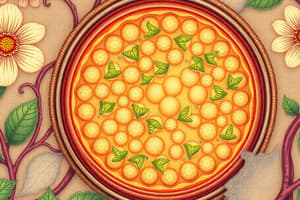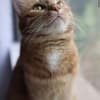Podcast
Questions and Answers
What is the primary function of mitochondria in a cell?
What is the primary function of mitochondria in a cell?
- Protein synthesis
- Modification of proteins
- Storage of genetic material
- Production of energy (ATP) (correct)
Which of the following correctly describes a prokaryotic cell?
Which of the following correctly describes a prokaryotic cell?
- Lacks a nucleus and is smaller than eukaryotic cells (correct)
- Has a nucleus and larger in size
- Typically found in multicellular organisms
- Contains organelles such as mitochondria
What is the process by which plants convert light energy into chemical energy?
What is the process by which plants convert light energy into chemical energy?
- Transpiration
- Photosynthesis (correct)
- Fermentation
- Cellular respiration
Which organelle is responsible for modifying and packaging proteins?
Which organelle is responsible for modifying and packaging proteins?
What type of nutrition do plants primarily use to produce their food?
What type of nutrition do plants primarily use to produce their food?
Which type of respiration occurs without oxygen and produces less energy?
Which type of respiration occurs without oxygen and produces less energy?
What distinguishes plant cells from animal cells?
What distinguishes plant cells from animal cells?
In which part of the ecosystem would decomposers be found?
In which part of the ecosystem would decomposers be found?
Flashcards are hidden until you start studying
Study Notes
Cell Structure and Function
- Cell: Basic unit of life.
- Types of Cells:
- Prokaryotic: No nucleus, smaller (e.g., bacteria).
- Eukaryotic: Contains nucleus, larger (e.g., plant and animal cells).
- Organelles:
- Nucleus: Control center, contains DNA.
- Mitochondria: Energy production (ATP).
- Ribosomes: Protein synthesis.
- Endoplasmic Reticulum (ER):
- Rough ER: Studded with ribosomes; protein synthesis.
- Smooth ER: No ribosomes; lipid synthesis.
- Golgi Apparatus: Modifies and packages proteins.
- Chloroplasts: Site of photosynthesis in plant cells.
- Cell Membrane: Protects cell; regulates transport.
Plant vs. Animal Cells
- Plant Cells:
- Have a cell wall, chloroplasts, and large central vacuoles.
- Animal Cells:
- No cell wall; smaller vacuoles; lysosomes present.
Photosynthesis
- Process: Conversion of light energy to chemical energy.
- Location: Chloroplasts in plant cells.
- Equation:
- 6CO2 + 6H2O + light energy → C6H12O6 + 6O2
- Importance: Produces oxygen and glucose.
Nutrition in Plants
- Types of Nutrition:
- Autotrophic: Plants synthesize their food using sunlight.
- Heterotrophic: Organisms obtain food from other sources.
- Modes of Nutrition:
- Photosynthesis: Main mode for most plants.
- Wuthering: Some plants trap insects for nutrients (e.g., Venus flytrap).
Respiration
- Types:
- Aerobic: Requires oxygen; produces more energy.
- Anaerobic: Occurs without oxygen; less energy produced.
- Equations:
- Aerobic: C6H12O6 + 6O2 → 6CO2 + 6H2O + energy (ATP)
- Anaerobic (in animals): C6H12O6 → 2C3H6O3 + energy (ATP)
Reproduction
- Types:
- Asexual Reproduction: Involves one parent (e.g., budding, fragmentation).
- Sexual Reproduction: Involves two parents, combining genetic material (e.g., seed formation).
Ecosystem and Environment
- Ecosystem: Interaction between living organisms and their environment.
- Components:
- Biotic: Living organisms (plants, animals).
- Abiotic: Non-living factors (water, soil, climate).
- Food Chain: Sequence of energy transfer (producers → consumers → decomposers).
Human Anatomy and Physiology
- Organ Systems:
- Digestive: Breaks down food; absorption of nutrients.
- Respiratory: Gas exchange (O2 in, CO2 out).
- Circulatory: Transports nutrients, gases, hormones.
- Excretory: Removal of waste.
Importance of Biodiversity
- Biodiversity: Variety of life in the world or a particular habitat.
- Roles:
- Ecosystem resilience.
- Economic benefits (medicinal resources, agriculture).
- Aesthetic and ethical value.
Health and Diseases
- Key Concepts:
- Disease: Any condition that impairs normal bodily function.
- Infectious vs. Non-infectious.
- Importance of hygiene and vaccination in disease prevention.
Cell Structure and Function
- Cells are the fundamental units of life.
- Prokaryotic cells lack a nucleus and are smaller, like bacteria.
- Eukaryotic cells have a nucleus and are larger, like plant and animal cells.
- Organelles are specialized structures within cells with specific functions.
- Nucleus: The cell's control center, containing DNA.
- Mitochondria: Powerhouses of the cell, generating energy (ATP).
- Ribosomes: Sites of protein synthesis.
- Endoplasmic Reticulum (ER): A network of membranes involved in various functions.
- Rough ER: Studded with ribosomes, responsible for protein synthesis.
- Smooth ER: Lacks ribosomes, involved in lipid synthesis.
- Golgi Apparatus: Packages and modifies proteins.
- Chloroplasts: Found in plant cells, responsible for photosynthesis.
- Cell Membrane: Protects the cell and controls the movement of substances in and out.
Plant vs. Animal Cells
- Plant cells have a cell wall, chloroplasts, and a large central vacuole.
- Animal cells lack a cell wall, have smaller vacuoles, and contain lysosomes.
Photosynthesis
- The process of converting light energy into chemical energy stored in glucose.
- Takes place in chloroplasts of plant cells.
- Equation: 6CO2 + 6H2O + light energy → C6H12O6 + 6O2
- Essential for producing oxygen and glucose, which are vital for life.
Nutrition in Plants
- Autotrophic organisms, like plants, produce their own food using sunlight.
- Heterotrophic organisms obtain food from other sources.
- Photosynthesis is the primary mode of nutrition for most plants.
- Carnivorous plants trap insects for nutrients (e.g., Venus flytrap).
Respiration
- Aerobic respiration requires oxygen and produces more energy.
- Anaerobic respiration occurs without oxygen and produces less energy.
- Aerobic Respiration Equation: C6H12O6 + 6O2 → 6CO2 + 6H2O + energy (ATP)
- Anaerobic Respiration (in animals) Equation: C6H12O6 → 2C3H6O3 + energy (ATP)
Reproduction
- Asexual reproduction involves one parent (e.g., budding, fragmentation).
- Sexual reproduction involves two parents, combining genetic material (e.g., seed formation).
Ecosystem and Environment
- Ecosystem: The interaction between living organisms and their environment.
- Components:
- Biotic: Living organisms (plants, animals).
- Abiotic: Non-living factors (water, soil, climate).
- Food Chain: A sequence of energy transfer from producers to consumers and finally to decomposers.
Human Anatomy and Physiology
- Organ Systems are groups of organs that work together to perform specific functions.
- Digestive system: Breaks down food and absorbs nutrients.
- Respiratory system: Responsible for gas exchange (oxygen in, carbon dioxide out).
- Circulatory system: Transports nutrients, gases, and hormones throughout the body.
- Excretory system: Removes waste products from the body.
Importance of Biodiversity
- Biodiversity refers to the variety of life found in the world or a specific habitat.
- Roles:
- Enhances ecosystem resilience.
- Provides economic benefits (medicinal resources, agriculture).
- Holds aesthetic and ethical value.
Health and Diseases
- Disease: Any condition that impairs normal bodily function.
- Infectious diseases are caused by pathogens and can be transmitted.
- Non-infectious diseases are not caused by pathogens.
- Hygiene and vaccination play crucial roles in disease prevention.
Studying That Suits You
Use AI to generate personalized quizzes and flashcards to suit your learning preferences.





